This site uses only a few technical cookies necessary for its operation. By continuing to browse, you accept their use.
To find out more...
To find out more...
Boiling potatoes in their skins
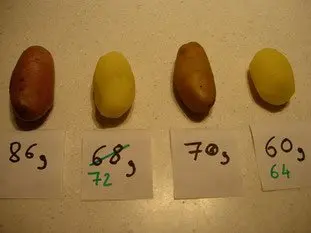
Boiling potatoes has given rise to two sayings:
1) You should not peel potatoes before boiling.
2) You should not leave potatoes to cool in the cooking water.
The first suggests that potatoes should be always cooked in their skins, to prevent water penetrating and making the potatoes go soft and break up.
The second suggests that if potatoes cool in their cooking water, they will absorb some of it, which will give them an unpleasant flavour.
True or false? Let's try the experiment...
1) You should not peel potatoes before boiling.
2) You should not leave potatoes to cool in the cooking water.
The first suggests that potatoes should be always cooked in their skins, to prevent water penetrating and making the potatoes go soft and break up.
The second suggests that if potatoes cool in their cooking water, they will absorb some of it, which will give them an unpleasant flavour.
True or false? Let's try the experiment...
Last modified on: July 25th 2017
For 4 pieces, you will need:
- 1
 4 potatoes
4 potatoes - Total weight: 640 grams
Times for this recipe
Preparation: 20 min.
Cooking: 10 min.
All in all: 30 min.
If you start now, at , you will finish around : ?.Change start time
To finish around 7pm, you'll need to have started before: .Change end time
Step by step recipe
Stage 1
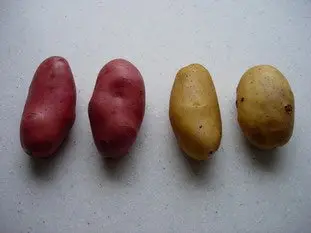
4 potatoes, of 2 different varieties (roseval and bintje here), will be used for a thorough test.
Stage 2 - ⌛ 10 min.
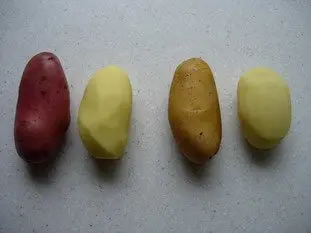
One of each kind is peeled.
Stage 3 - ⌛ 5 min.
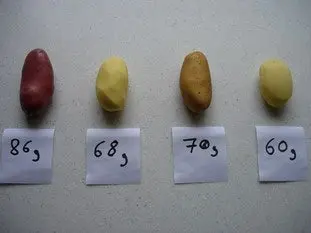
All 4 are washed and dried, then weighed precisely and the weights noted.
Stage 4 - ⌛ 10 min.
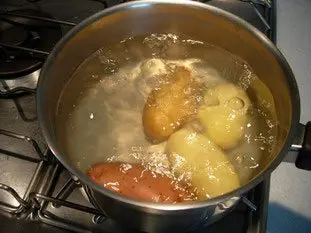
The potatoes are all boiled in water.
Stage 5 - ⌛ 5 min.
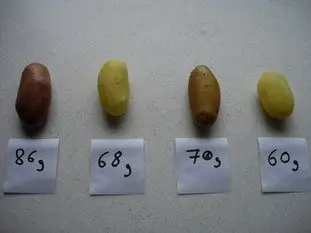
When cooked, the potatoes are removed from the water, dried and weighed again.
Result: no change in weight.
Conclusion "You should not peel potatoes before boiling": false, peeled or not they behave the same.
Result: no change in weight.
Conclusion "You should not peel potatoes before boiling": false, peeled or not they behave the same.
Stage 6

Next the potatoes are left to cool in their cooking water until cold, then dried and weighed again.
Result: the weight of the peeled potatoes has increased by 4 grammes each.
Conclusion "You should not leave potatoes to cool in the cooking water": it's true if they are peeled, otherwise they will absorb some of the water.
Result: the weight of the peeled potatoes has increased by 4 grammes each.
Conclusion "You should not leave potatoes to cool in the cooking water": it's true if they are peeled, otherwise they will absorb some of the water.
Conclusion
Both true and false: It's not necessary to leave the skins on potatoes for boiling, peeled or unpeeled they do not absorb water during cooking.
But you should not leave peeled potatoes to cool in the cooking water, because they will absorb water (about 7% in these tests). On the other hand, this "sponge" property of peeled potatoes might be an advantage when cooking them in something other than water, milk or cream for example, as they will absorb some of the good flavour.
But you should not leave peeled potatoes to cool in the cooking water, because they will absorb water (about 7% in these tests). On the other hand, this "sponge" property of peeled potatoes might be an advantage when cooking them in something other than water, milk or cream for example, as they will absorb some of the good flavour.
Source: Home made.
Nutritional information
| Proteins (gr) | Carbohydrates (gr) | Fats (gr) | Energy value (in k-calories) | Energy value (in k-joules) | |
|---|---|---|---|---|---|
| Whole recipe | 10 RDI=5 % | 120 RDI=10 % | 0 | 540 RDI=30 % | 2,280 RDI: 30 % |
| Per 100 g | 2 RDI=1 % | 20 RDI=2 % | 0 | 90 RDI=4 % | 360 RDI: 4 % |
| Per piece | 3 RDI=1 % | 30 RDI=3 % | 0 | 140 RDI=7 % | 570 RDI: 7 % |
How much will it cost?
- For 4 pieces : 0.65 €
- Per piece : 0.20 €
Change currency:
Note: Be careful, these prices are only an estimate, you can consult the table of prices by ingredients used for this estimate.
This recipe uses (among others)

Potatoes
Like these other recipes: Minestrone, Mushroom velouté, Morteau sausage , Zucchini and potato scarpaccia, Comtoise tart for Seàn, ... See them all 85
Other recipes you may also like
Mushrooms on toast, French style
This is a French version of mushrooms on toast! The mushrooms are simmered in cream then served on a slice of fried buttered bread. April 6th 2017237 K3.8 2 hours 5 min.
Agen prune cake
This cake from Agen, in southwestern France, is a type of brioche. Inspired by the famous "tarte au sucre" (sugar tart), it is like a thick "galette" with a moist texture, filled with prunes and marzipan with Armagnac. September 16th 201858 K3 1 hour 55 min.
How to succeed in making sabayon (syllabub)
A sabayon is a delicious and delicate preparation based on egg yolks and sugar, with a liquid added (wine, alcohol, fruit juice, etc), which is then whipped in a bain-marie until it is both light and smooth. Usually sabayon is sweet (syllabub), but you can make it savoury, in which case there is only egg yolk, salt, and the chosen liquid, which could be stock, reduced wine, roasting juices, etc... This recipe is for a... November 12th 2017955 K 54 20 min.
Potato gratin
This classic French recipe is made with sliced potatoes baked in milk and browned on top. February 21th 20111.12 M 14.4 1 hour 50 min.
Small foie gras pasties
Dainty pasties, filled with a morsel of seasoned foie gras. September 7th 2018334 K4.6 2 hours
News list of cooking-ez.com
Sign up to receive the latest recipes (next batch due to be sent on 2026-01-04)
Note: We'll never share your e-mail address with anyone else.
Follow this recipe
If you are interested in this recipe, you can "follow" it, by entering your email address here. You will then receive a notification immediately each time the recipe is modified or a new comment is added. Please note that you will need to confirm this following.
Note: We'll never share your e-mail address with anyone else.
Alternatively: you can subscribe to the mailing list of cooling-ez.com , you will receive a e-mail for each new recipe published on the site.

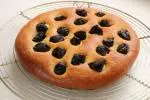



The 3 comments already posted on this recipe
The next step of the experimentation would be probably to cook potatoes with and without skin, peel those with skins, cut them in pieces in differents plates with numbers, call few friends for a "blind taste potatoes party" (prepare some bottles of wine and paté too, otherwise I'm not sure they will come) and then try to determinate which ones are the bests.